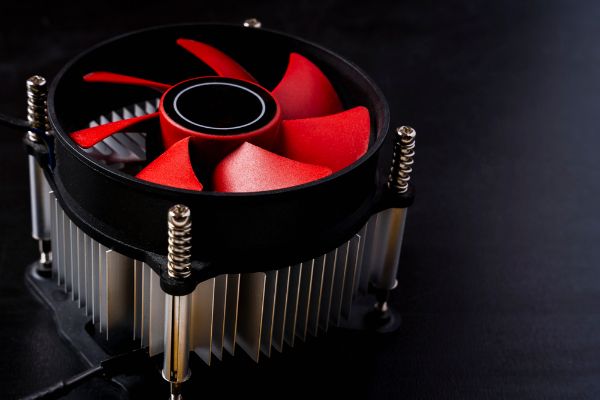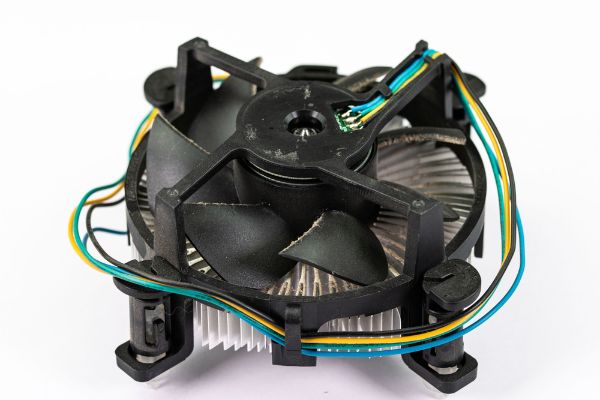Disclaimer: This post may contain affiliate links, meaning we get a small commission if you make a purchase through our links, at no cost to you. For more information, please visit our Disclaimer Page.
Your computer does a lot of work for you, and its various hats can include entertainment, research, business, or a host of other things. Many people use their desktops or laptops for combinations of all these things, multiple times throughout the day or night.
Like anything that works hard, the computer gets warmer as it generates heat while it is using energy. Extreme heat does not mix well with sensitive electronics, and heatsinks are one of the ways developers can help computers combat this buildup.
If you’ve opened up your computer or built any kind of test system, you may notice that the heatsink can get pretty hot. We’ll discuss some of the reasons why it is particularly warm, how hot might be too hot, if things are supposed to be warm to the touch, and other things related to the device’s temperature.
Furthermore, we’ll talk about why or how some sinks might go bad, what some of the problem areas are, and what you might do about them.
Table of Contents
Why Is the Heatsink So Hot?
To determine how and why a heatsink might get quite hot, let’s dive into just what it is.
A heatsink is an exchanger that helps to transfer temp buildups from hardware and mechanical components to something else. In essence, it helps to siphon off heat that your computer’s parts generate and put it somewhere else so they can stay cool.
Most commonly, liquid or air mediums are how the heatsink will transfer the excess. When it comes to computers, you’ll find that central processing units and graphics processing units are two of the main things that make use of heatsinks most often. Some kinds of RAM will also come with heatsinks or spreaders to take care of their heat.
Your heatsink is dealing with the heat that comes off of components like the GPU or CPU, and these things do a lot for the computer. In most cases, they’ll run at some capacity for as long as you use the device.
This means that the heatsink might have a job that is nearly constant, although that can depend on what the computer is doing in terms of processes.
Because the heatsink’s job is to help dissipate things and keep the temperatures around some components at normal levels, it can get to where it feels hot.
Is It Normal for a Heatsink To Get Hot?
The answer to this question can depend on what we mean when we say “hot.” There are ways to measure the actual temperatures of the CPU and other components of your system.
Using these readouts, you can determine if some of your hardware might not be working a bit too hard. The recommended temperature ranges for your device can depend on what kind of CPU or GPU it is working with, and you can check with the manufacturer of your components to figure out what the range is for you.
Having said that, a heatsink should never feel like it is burning hot. It is normal to have a heatsink that feels very warm, but an overly hot heatsink is indicative of a problem somewhere.
If the heatsink feels like it is burning up, it could mean that it is saturated and having trouble dealing with how much heat is generated from the components. This is bad for the heatsink, but it also means that there could be a bigger issue at play with the parts that rely on the heatsink.
It may be a good idea to find software that can help you monitor the internal temperatures for your computer. You can configure most of these to alert you to a problem quite easily, and they should be able to get a reading on which parts are outside the normal temperature range.
There are several free programs out there that can monitor the temperatures for you. Once you’ve downloaded and installed the program of your choice, you may need to do some configuring in order to establish a baseline from which the application can work.
How Hot Should a Heatsink Get?
How hot a heatsink should get can be relative to the type of CPU you have, the heatsink you have, how you’re running your system, and what other components you might be using.
Therefore, what is hot could change from one rig to another. However, we can still make some educated guesses that fall within acceptable ranges for heatsink temperatures.
Many modern CPUs are rated to be able to operate free from errors at temperatures approaching 100 degrees Celsius, although you don’t necessarily want your CPU to run that hot, particularly not for long periods of time. Additionally, some heatsinks may have trouble dealing with temperatures that hot, too.
Recommended values for a CPU may sit at quite a bit lower, and approaching the upper end for any length of time could mean damage to the processor in the long run.
Generally, the better your heatsink is, the cooler it will be. However, you don’t really want a cold heatsink, either. A heatsink that is too cold indicates that it may have a fault preventing it from doing its job, just like one that feels like it is way too hot. You should still feel some warmth or get readings to that effect when the machine is active.
We’re still talking about a temperature range here, and that is a matter of the flow of heat from the components to the heatsink itself. Although you want to make sure the heatsink can handle the heat coming off the CPU or GPU, heating up is not as much of a problem for the sink as it is for the chips themselves.
Different brands and models of heatsinks on the market will have different ranges, so how hot they should get when running well is something that one could debate.
You can look at the thermal dissipation measurements to determine where the effective temperature ranges are. Many kinds of computer coolers have what some manufacturers call a ’Thermal design power’ rating that can help you understand how much heat they can deal with at once.
If your CPU and its heatsink are on the higher end of the performance spectrum, you might expect to see the sink get rather warm but not very hot if you’re using the rig for light gaming and other applications. These are the sorts of tasks that don’t require tons of resources that might produce heat.
Should a CPU Heatsink Be Hot When Touched?
The heatsink should at least be warm when you touch it if the computer has been in use for a while. All heatsinks cool down eventually as the heat dissipates once the desktops are turned off.
Furthermore, they will usually stay cool after the computer begins its operations, only getting warmer as the CPU builds up enough heat to have the sink siphon off some of it. Again, whether it is hot can depend on the relationship between your CPU and the heatsink itself.
Because processors are some of the main components that get very warm as they are being used, they come with different kinds of stock coolers when you purchase them.
A cooler is anything that helps different components keep their temperatures in check, and a heatsink represents one type of cooler. However, just because a processor comes with a particular heatsink, that doesn’t mean it is the one you have to use with your system.
The stock cooler might be sufficient, but you can change it for a different one that you like, and this could bring about some changes in how the heatsink feels. If you get one that is meant for a much more powerful CPU than the one you have in your system, it is possible that it will feel quite cool even when it is operational.
Can Heatsinks Go Bad?
Yes and no. It is extremely rare for the heatsink itself to go bad in the same ways that some of the more delicate parts of your computer might. It is a rugged thing made from various robust materials that can withstand a lot of issues.
It isn’t common for the heatsink itself to go bad unless it takes any kind of physical damage that could harm its parts or unseat it somehow.
Sometimes, the heat pipe might fail, but it isn’t common. This is the pipe that sits between the contact plate and the heatsink itself, and it should be made from copper components.
It is more common that the component might get clogged from dust or debris and lose some of its effectiveness that way. It doesn’t fail, but it may not do its job on the level that you’re expecting until it is cleaned up.
What Are Some Signs of a Clogged Heatsink?
There are a few common signs you can look for that might point to a clogged heatsink:
1. A fan that runs loud or often could be a sign of a clogged heatsink. In this case, the computer’s fan may be working harder than it normally would to compensate for the lack of help from the heatsink.
It is important to clean the heatsink soon if you notice this. Eventually, the fan alone won’t be enough to cool down the system.
2. General temperatures are getting too hot. This could be one of the first signs that there is a problem with the cooling for the computer. However, it might not be something you can recognize immediately.
The changing temperatures inside the rig are not necessarily reflective of how the tower casing might feel to you when you touch it. To check on this, you can download some of the software we alluded to earlier and track the internal temperatures.
3. An unstable system that stutters, stops, or restarts itself randomly could be a sign that the heatsink is clogged. The problems with this component are leading to critical temperatures inside the computer, and these temps are causing problems with how the system is running overall.
How Can I Fix A Clogged Heatsink?
You can fix this problem by cleaning out the heatsink. Here are a few basic steps to follow:
- Completely shut the computer down and unplug it.
- Open the case and remove the CPU fan to gain access to the heatsink. Since you’re here, it might be a good idea to clean the fan as well.
- The heatsink has thin sheets of metal. Use some compressed air to blow dust and debris out of the gaps between these sheets and away from the heatsink.
- For extreme clogs, you may need to use a lint-free rag to wipe away more of the debris that the air could not catch.
Conclusion
Processors and graphics engines play vital roles in computers, and heatsinks are there as sidekicks to play equally important roles. As part of the cooling system, they work in tandem with fans to make sure components inside don’t get too hot.
However, there are times where the heatsinks themselves might get too hot to do their jobs, or they may suffer from clogs that also decrease their efficiency.
You can use computer programs and your own judgment to keep track of how your heatsink is doing with internal computer temperatures. Cleaning it when you notice things getting too hot can also help.


